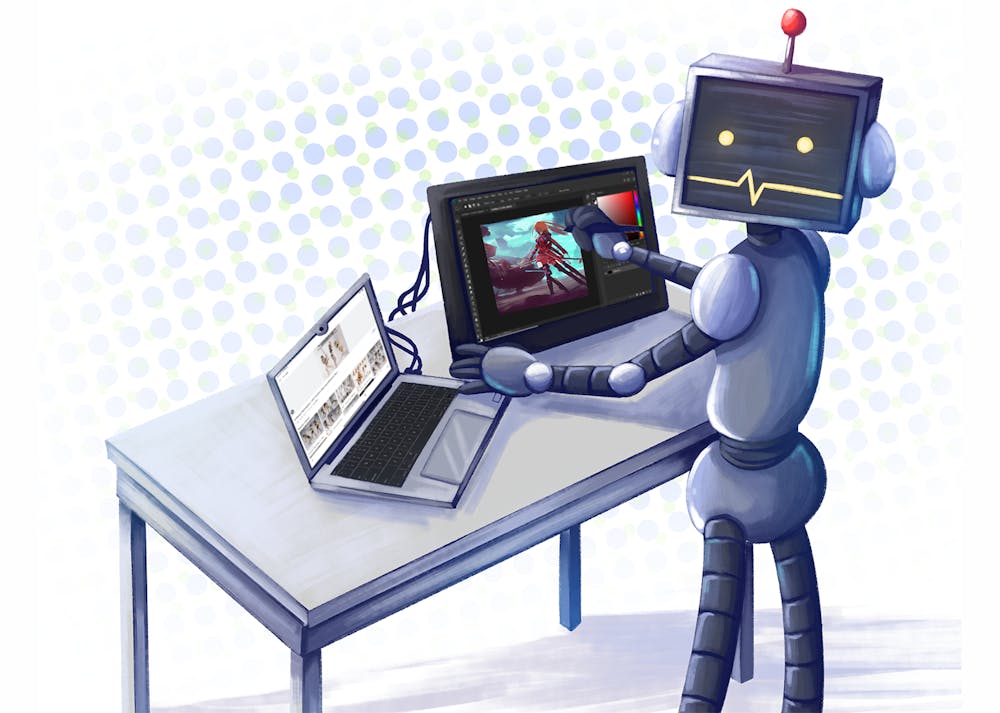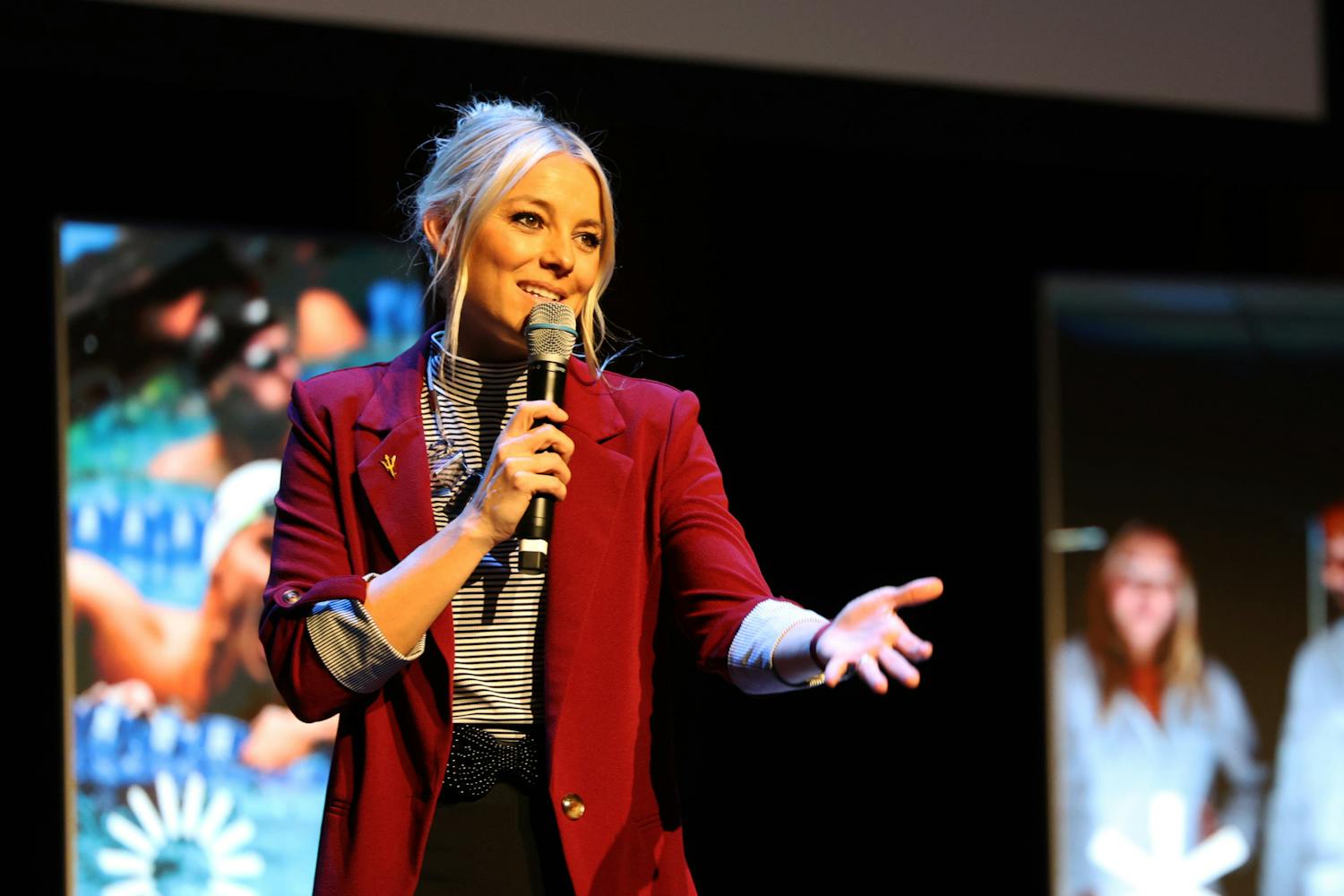Although he doesn’t consider himself an artist, Andrew Maynard, a professor at the School for the Future of Innovation in Society, used an AI art bot to create 56 images. He directed the bot Midjourney to create what most caught his eye and published the creations in September 2022.
Maynard considers his work with the AI bot a collaborative process where he directed the AI to refine images that inspired him. Although AI can create beautiful images, it cannot replicate the experience and creativity of human artists, he said.
“I think there’s a need to rethink the value of human-generated art,” Maynard said.
For example, a child creating art is a way the child is reflecting on their life experience. The value of the art isn’t the picture itself, but what it represents from the child, Maynard said. That can’t be replicated by a machine.
In the future, Maynard envisions AI art generators as a tool for those without technical artistic skills to express themselves creatively.
Adriene Jenik, a professor at ASU’s School of Art, has been an artist since she was a child.
“All my experiences of joy have to do with expressing myself either by myself or with other people,” Jenik said. “I really believe strongly in the power of creativity as a life force on Earth.”
AI art could take the place of human artists in the industry, Jenik said. For example, concept art that used to be created by artists can be generated in seconds by machines.
“This is a massive shift for the industry,” she said. “The challenge and the sad part of it is that machine learning has been done by scrubbing the internet of all our creativity for decades.”
Parallel views
AI-generated art has no way to come up with original concepts, styles or ideas on its own. Instead, it analyzes a set of images and attempts to produce a new image in the style of the images it analyzed.
AI art generators can even create pieces in similar styles to human artists, learning from images artists have posted online, often without asking artists for permission or crediting and compensating them fairly.
There’s currently no comprehensive legislation regarding AI on a federal level, said Gary Marchant, a professor of law at Sandra Day O’Connor College of Law who teaches a course on AI ethics, law and policy.
“The legal issues are changing so quickly all the time that it’s very hard for traditional regulation to even stay relevant,” Marchant said.
The new legal issue of AI using artwork without artists’ permission hasn’t been resolved yet, he said.
“If you have an AI system that uses data to train the system, what obligation does that company developing that AI system have to the creators of the underlying data?” he asked.
Marchant sees two ways of looking at the issue. On the one hand, AI is simply viewing a line of data — a human could hypothetically view 10 Picasso paintings and create a painting in Picasso’s style. In this view, AI is merely looking at existing art online and using it for its own purposes, which could be seen as fair use in a legal context.
In an alternative view, AI is using — or exploiting — creative data in a way the original artists don’t benefit from. This issue is a hot topic; a group of artists recently sued the creators of the AI used in popular art generators like Lensa for using their work in the AI’s database without permission.
Another legal question brought up by AI art bots is whether the art they generate can be copyrighted, Marchant said. Currently, the consensus is no: a human needs to be involved in the work directly to qualify for copyright.
“As AI systems do more and more of our creative inventions and discoveries, both in the arts and literature but also science, how do we create the right incentives so that they can’t get any intellectual property rights?” Marchant said. “That’s a huge new issue that is challenging our courts and legal system.”
While the legal and ethical issues are new, the concept of AI is not. The idea of AI — a computer mimicking human intelligence — was first introduced in the 1950s at a research conference. But it wasn’t until the last three decades that AI became advanced enough to outperform humans.
Recent innovations in AI have thrown universities into a tizzy, with professors reevaluating the ways they assess students, as easily accessible AI chatbots like ChatGPT make it easier for students to turn in work that isn’t their own.
READ MORE: ChatGPT Worries Professors, Excites Them For Future Of AI
AI art could be seen as a new tool for creativity, with people able to create with a few buttons and clicks, Jenik said, but the government and society need to decide on the ethical ways to implement them.
However, she fears the “existential threat” of rapidly expanding AI and the subsequent implications for creative jobs and the economy.
“We can’t stop it,” Jenik said. “Now the issue is going to be for artists and creative people to understand how to work within the machines.”
Putting the artist back into the art
Art is always evolving, said Lance Gharavi, a professor at the School of Music, Dance and Theatre. So far, he hasn’t seen any AI-generated images he wouldn’t consider art.
“A lot of people believe that art has to be the product of human labor, that the artist has to put effort and work into the thing, and that effort and work has to display a kind of skill,” Gharavi said. “So we marveled at the skill and labor of the artists. Well, that hasn’t been the way the art world has treated art for a long time.”
Gharavi noted how “readymade” art — mass-produced objects artists remove from their intended purpose, like a urinal, and display as art — have often been considered art without a human artist putting any effort into the creation of the initial artistic object. His positive perspective on AI art contrasts with the broader tempos of the art world.
“The culture is going through a lot of hand-wringing and questioning trying to figure this out, but we’ve been through such issues before — although I think the advent of generative AI is more culturally and socially significant than a lot of previous innovations,” Gharavi said.
He likes to think of AI as a “collaborator for creation.” Working with an AI is collaborating with something completely different from him in nearly every way, he said.
“What kind of visions can it produce that are surprising, that would never come from my mind?” Gharavi said. ”That is something that excites me.”
Kevin Baragona is a founder of DeepAI, an AI company that promises to “enhance your creativity,” according to their website. He said he sympathizes with artists who are concerned about their artwork being used in AI databases without their permission.
“This is something high on our minds because the artists do have a good point,” he said. “The way we see it is that AI learns from millions, if not billions of images. And when done right, it learned from it. It’s not stealing it. If you mixed together 10,000 people’s work to produce a new work, that’s not considered stealing.”
Baragona said DeepAI does not currently replicate specific living artists’ styles.
Maria Pliusnova, an engineer at DeepAI, said the company wants to find a way for artists to use AI to save time, rather than see the technology as a competitor.
“There’s a real potential that this technology becomes too powerful to handle, like too hot to touch,” Baragona said. “I like our current state of AI. We might be having more progress than we really need right now.”
Baragona said that there’s no telling where AI technology will be in the future, and he questioned whether technology may be advancing too rapidly.
“It’s probably beyond our current imagination,” he said. “I’m embedded in the field and I’m startled by what I’m seeing. If we really do invent computers better than people at everything, are we going to regret that?”
For Jenik, there’s something that human artists can do better than AI generators — at least for now: “We know how to be human.”
Art that connects with humans and reflects the human experience is something that a computer may not be able to replicate, Jenik said.
“AI art only knows from what’s already been done,” she said. “So if you think of the human imagination as limitless then there’s always things beyond that that can be expressed.”
Edited by Sam Ellefson, Camila Pedrosa, Alexis Moulton and Greta Forslund.
This story is part of The Automation Issue, which was released on March 15, 2022. See the entire publication here.
Reach the reporter at kbippus@asu.edu and follow @BippusKeetra on Twitter.
Like State Press Magazine on Facebook and follow @statepressmag on Twitter and Instagram.

Keetra Bippus is a reporter for State Press Magazine and a journalism student at Walter Cronkite School of Journalism and Mass Communication. She's previously reported for AZ Big Media and the Downtown Devil.




